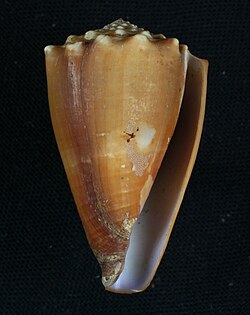Top Qs
Timeline
Chat
Perspective
Lividoconus
Subgenus of gastropods From Wikipedia, the free encyclopedia
Remove ads
Lividoconus is a subgenus of sea snails, marine gastropod mollusks in the genus Conus, family Conidae, the cone snails and their allies.[1]
In the latest classification of the family Conidae by Puillandre N., Duda T.F., Meyer C., Olivera B.M. & Bouchet P. (2015), Lividoconus has become a subgenus of Conus as Conus (Lividoconus) Wils, 1970 (type species Conus lividus Hwass in Bruguière, 1792) represented as Conus Linnaeus, 1758[2]
Remove ads
Distinguishing characteristics
Summarize
Perspective
The Tucker & Tenorio 2009 taxonomy distinguishes Lividoconus from Conus in the following ways:[3]
- Genus Conus sensu stricto Linnaeus, 1758
- Shell characters (living and fossil species)
- The basic shell shape is conical to elongated conical, has a deep anal notch on the shoulder, a smooth periostracum and a small operculum. The shoulder of the shell is usually nodulose and the protoconch is usually multispiral. Markings often include the presence of tents except for black or white color variants, with the absence of spiral lines of minute tents and textile bars.
- Radular tooth (not known for fossil species)
- The radula has an elongated anterior section with serrations and a large exposed terminating cusp, a non-obvious waist, blade is either small or absent and has a short barb, and lacks a basal spur.
- Geographical distribution
- These species are found in the Indo-Pacific region.
- Feeding habits
- These species eat other gastropods including cones.[3]
- Shell characters (living and fossil species)
- Subgenus Lividoconus Wils, 1970
- Shell characters (living and fossil species)
- The shell is obconic in shape. The protoconch is multispiral. The shell is ornamented with nodules which either persist or die out in the outer whorls. The anal notch is shallow. The shell has a distinct interior color layer and well developed constrictions inside the aperture. The anterior end of the shell is blue-black, blue or brown in color. The periostracum is tufted, and the operculum is small to moderate in size.
- Radular tooth (not known for fossil species)
- The radular tooth is elongated, and the anterior section of the radular tooth is equal to slightly longer than the length of posterior section. A basal spur is present, and the barb and blade are short. A partially exposed terminating cusp is present.
- Geographical distribution
- The majority of the species in this genus occur in the Indo-Pacific region, and one species occurs in the Eastern-Pacific region..
- Feeding habits
- These cone snails are vermivorous, meaning that the cones prey on a broad variety of polychaete worms, including enteropneust, eunicid, terebellid, cirratulid, maldanid, and nereid worms, and hemichordates.[3]
- Shell characters (living and fossil species)
Remove ads
Species list
This list of species is based on the information in the World Register of Marine Species (WoRMS) list. Species within the genus Lividoconus include:[1]
- Lividoconus biliosus (Röding, 1798) is equivalent to Conus biliosus (Röding, 1798)
- Lividoconus conco (Puillandre, Stöcklin, Favreau, Bianchi, Perret, Rivasseau, Limpalaër, Monnier & Bouchet, 2015): synonym of Conus conco Puillandre, Stöcklin, Favreau, Bianchi, Perret, Rivasseau, Limpalaër, Monnier & Bouchet, 2015
- Lividoconus diadema (G.B. Sowerby I, 1834) is equivalent to Conus diadema G. B. Sowerby I, 1834
- Lividoconus floridulus (A. Adams & Reeve, 1848) is equivalent to Conus floridulus A. Adams & Reeve, 1848
- Lividoconus lividus (Hwass in Bruguière, 1792) is equivalent to Conus lividus Hwass in Bruguière, 1792
- Lividoconus muriculatus (G.B. Sowerby I, 1833) is equivalent to Conus muriculatus G. B. Sowerby I, 1833
- Lividoconus sanguinolentus (Quoy & Gaimard, 1834) is equivalent to Conus sanguinolentus Quoy & Gaimard, 1834
Remove ads
References
Further reading
External links
Wikiwand - on
Seamless Wikipedia browsing. On steroids.
Remove ads

